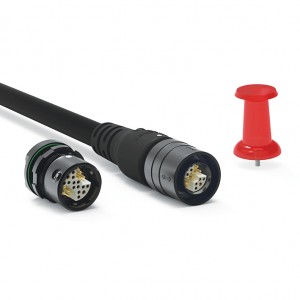
Trends in rugged connectors: What’s new for 2016?
By David Cianciolo, Director of Engineering, Fischer Connectors
Interconnect EngineeringBuilding things smaller, lighter and smarter has been driving engineers for the better part of this century. It started with consumer technology almost as soon as the PC was invented, and moved a little slower into the industrial sphere where technology doesn’t change as fast.
We don’t see an end in sight for this mega-trend. But what is really driving the most recent change in connectors is the huge amount of data that is routed to devices and people. Measurement is the mantra of every business manager everywhere, and big data is about to roll into your organization and impact the way you build devices, whether you like it or not. 
IT professionals pontificate daily about the data explosion, predicting that data production in 2020 will be 44 times greater than it was in 2009. Gigs and terabytes aren’t enough anymore. They talk about zettabytes, exabytes and petabytes, and the exponential growth of data centers. How data goes ‘through the cloud’, where it is stored, and more importantly, what to do with it, has become a central discussion for IT managers. But the data has to come from somewhere, and it comes when engineers build continuously smarter devices that talk to each other and make decisions based on the data that they receive and analyze.
This data explosion impacts the connector industry in a variety of ways.
Get and distribute more data
More sensors! We are counting, weighing and measuring more and more things because we want technology to be proactive, and every sensor we add needs a way to send its data back to another device or the mothership. If it is a small amount of data that isn’t time sensitive or critical, some people are doing away with connectors all together and going wireless, but wireless isn’t good enough yet for a lot of time-sensitive data flowing through areas where interference could impact safety, accuracy of data, or even lives. So the evolution of connectors helps influence sensor device size and functionality. The smaller and more rugged the connector becomes, the smaller the sensor or measuring device becomes, and the more mobile it becomes.
Do more, but consume less
In Canada, Kevin Hawley of Matrix Technology just outside of Toronto says there is a movement to minimize connection points by utilizing one multi-functional connector versus several performing the same function. This trend fulfills the demand to reduce waste – to increase functionality while using fewer materials. It’s another reason why we talk to more customers about hybrid connectors, whether it is a straight up copper with both power and signal, or whether it is a fiber-copper hybrid connector for applications that need to move a lot of data such as broadcast or video surveillance. We have discussions daily about plastic vs. aluminum vs. brass vs. stainless steel and even fiber, and going through decision trees to figure out the best material for their connectors that will do the job with minimal waste or environmental impact. That extends to the kinds of cables people choose as well, and it is driving decisions to smaller connectors in many cases. Another interesting environmental turn is the military moving away from colored chromate to a non-carcinogenic anthracite coating to protect against reflection.
Go where we haven’t gone before
The tougher and more mobile devices being designed means that engineers are looking at smaller connectors that can withstand temperature extremes, vibration, and an environment that might be wet or dirty. When you can connect once and let it go, the trend is toward nano connectors that take care of signal. In cases where the user has to disconnect and reconnect the devices, the trend is toward smaller, more dense connectors that can carry signal and power with one connection instead of two for ease of use.
Fischer Connectors has been concentrating on replacing two and sometimes three connectors with one miniature, dense multi-functional connector to help engineers build smaller, more functional devices that still meet demands for market competitiveness. This trend towards miniaturization continues to impact almost everything from drones to communications devices to instrumentation and medical devices.

